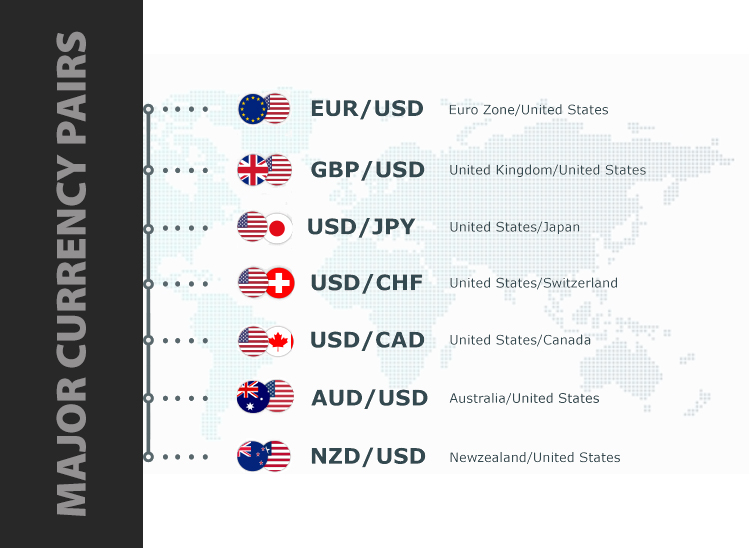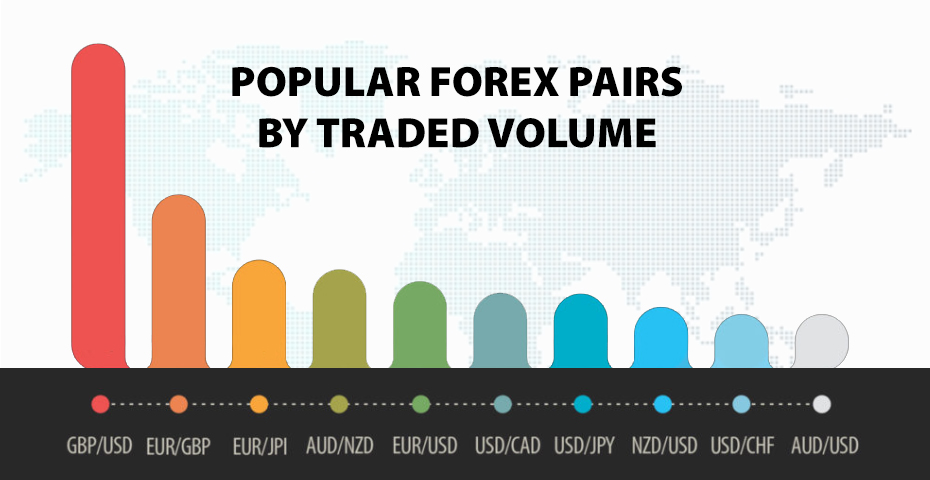Best Forex Pairs to Trade
With so many pairs to choose from, how can you pick the best forex pairs to trade?
Well, this is what we are going to find out in this guide.
We’ll break down different types of currency pairs, and which of them can soar your profits.
So, let’s get started!
What are currency pairs?
First up, what are currency pairs?
The forex market is all about trading currencies. If you're buying or selling, you'll still be exchanging one currency for another.
The value of one currency's worth in comparison to the other currency is what defines a currency pair.
The base currency in a pair is the first currency in the pair, such as the British pound in GBP/USD. The quote currency is the second currency, the US dollar.
A forex currency pair's price is an expression of how much of the quote currency is needed to buy one unit of the base currency.
A value of GBP/USD 1.39, for example, means that $1.39 would buy one Pound.
Types of currency pairs
Forex pairs have four categories; majors, minors, crosses, and exotic.
Let’s discuss each one of them:
1. Majors
Majors are the most common form of currency pair to trade. They always include the US dollar and are usually the most liquid; that is, they offer the trader the most flexibility in trading the pair on the forex market.
Majors have the highest liquidity of the four types of currency pairs; but, since these currencies are usually easier to evaluate, trading majors can be crowded and competitive.

2. Minors
Minors are currencies that do not include the US dollar but do include one of the other major currencies (for instance, the Euro).
They have lower liquidity than major currencies, and there is usually fewer data available on these currencies.
Trading minor currency pairs are, therefore, less competitive than traders might be able to leverage.
3. Crosses
Any currency pairing that does not involve the US dollar is referred to as a cross.
What separates this from a minor?
A minor must contain one of the major currencies (for example, the Euro), while a cross can contain any non-US dollar currency.
4. Exotics
An exotic currency doesn't have much volume. Exotic currencies are illiquid, have little market depth, can be highly volatile.
Trading exotic currencies can be costly since the bid-ask spread is usually wide to make up for lack of liquidity.
Examples of exotics currency pairs include AUD/MXN, USD/NOK, GBP/ZAR.
Factors to consider before choosing a forex pair
Before jumping in to choose the best forex pair, its best to consider a few factors:
a. Liquidity
This is usually the most important consideration when determining which currency pairs to trade. You want to trade currency pairs that you can quickly buy and sell as a trader.
The exception to this rule is the trader who wants to profit from the volatile output of less liquid currency pairs. This is known as scalping, and it entails taking small profits several times during the day.
b. Info on currency pairs
The advantage of trading major currency pairs or pairs involving any major global currency is a large amount of data available to forecast how a currency would work.
Smaller global currencies, especially those that are new to the forex market, will have less historical data, making their output more difficult to forecast.
c. Economic considerations
A currency's market stability is related to the economic health of the nation or nations associated with that currency.
For example, the US to the US dollar or the British pound to the UK.
When deciding which currency pair to use, consider the possible economic situation of those countries.
What is the Best Currency Pair to Trade?
Ok, let’s start the juicy part of the guide. Now that you know, what forex currency pairs are, their types, and what factors affect them, it’s time to tell you which are the best forex pairs.
1. EUR/USD
The United States Dollar (USD) is the most commonly traded currency in the world since it is the world's most dominant reserve currency and the currency of the world's largest economy.
The European Union Euro (EUR) is second in strength, making this pair the most formidable in terms of liquidity and capturing the lion's share of market action. This pair has a negative correlation with the USD/CHF but a positive correlation with the GBP/USD.
Correlation is a statistical indicator of the forex pair's relationship with another. Currency correlation processes the degree to which two currency pairs moved in the same or opposite directions over a given period.
2. GBP to USD
This major pair consists of the British pound and the US dollar and, as a result, is affected by the health of the British and American economies.
This pair's related exchange rate is determined by interest rates set by the Bank of England and the US Federal Reserve.
GBP/USD is popularly known as the "cable." The pair has a negative correlation with the USD/CHF but a positive correlation with the EUR/USD.
3. JPY to USD
The USD and the Japanese Yen are the next most common trading pair. This pair is more sensitive because it reflects the political situation between the two economies at any given time.
This pair is commonly known as the "gopher." These pairs correlate positively with the USD/CHF and USD/CAD pairs.
4. AUD/USD
This is yet another significant pair. The value of commodities exported by Australia, such as iron ore, gold, and coal, as well as interest rates set by the Reserve Bank of Australia and the US Federal Reserve, influence this pair.
This currency pair is known as the "Aussie." The pair has a negative correlation with the USD/CAD, USD/CHF, and USD/JPY.
5. USD to CAD
USD and its northern neighbor, the Canadian Dollar (CAD), are next on the list of best currency pairs to trade.
This trading pair is also known as trading the "loonie." This pair has a negative correlation with the AUD/USD, GBP/USD, and EUR/USD.
6. USD/CHF
Moving down the list of the most common trading pairs, the next pair on the list is the USD to Swiss franc (CHF).
This currency pair is called the "Swisse." The EUR/USD and GBP/USD pairs appear to have a negative correlation with USD/CHF. In turbulent times, the Swiss franc has traditionally been viewed as a safe haven for traders.
7. EUR/GBP
Since it does not contain the US dollar, this is a minor pair. It consists of the Euro and the British pound.
Because of the geographical location and good trading ties between Europe and the United Kingdom, this is a challenging pair to forecast.
The price of EUR/GBP has been extremely volatile in the run-up to the UK's exit from the EU.
Interest rates set by the Bank of England and the European Central Bank are also important to watch for EUR/GBP.
8. NZD/CHF
The New Zealand dollar and the Swiss franc are included in this minor pair.
Because of New Zealand's growing agricultural presence around the world, any trader looking to invest in this pair must keep an eye on global agricultural product prices.
The Reserve Bank of New Zealand also affects the price of this pair.
Here’s a list of popular forex pairs according to volume:

The Best Pairs for Scalping
As scalping is the popular form of trading, we thought it is a good idea to tell you which pairs are best for scalping.
Scalpers tend to trade the most common currency pairs, with EUR/USD, USD/CHF, GBP/USD, and USD/JPY being their top picks.
Scalpers favor these pairs because they move steadily in the market and have the largest volume of trading. Furthermore, since these pairs are very stable, scalpers may take advantage of them to gain consistent, although moderate, income.
Highly Volatile Currency Pairs
Volatility tells traders how much a currency's price will change from its current level over a given period of time.
Since major currency pairs have far more market liquidity, they are usually less volatile than other currency pairs.
For instance, the EUR/USD pair is less unpredictable than USD/ZAR pairs (South African rand).
In terms of major currencies, the most volatile are the AUD/JPY, NZD/JPY, AUD/USD, CAD/JPY, and AUD/GBP.
The most significant difference between trading high volatility currencies and trading low volatility currencies is that high volatility currencies can move more pips over a given period of time than lower volatility currencies. This can contain high risk if you are new to forex trading. High volatility pairs are also more susceptible to slippage.
Bottom line
Trading Forex pairs offer the possibility for a sizable profit, but it takes patience and consistent analysis.
Keep in mind that increased volume contributes to increased liquidity and market stability. This does not necessarily imply that these are the best pairs to trade.
However, as always, you must consider your trading strategy and skills, as well as your goals, in order to make the best decisions for you.
Just because someone makes a good living off one pair does not mean the pair would fit into your strategy.
Click on the button below to Download our "Best Forex Pairs to Trade" Guide in PDF


